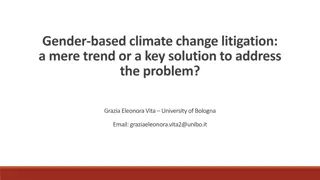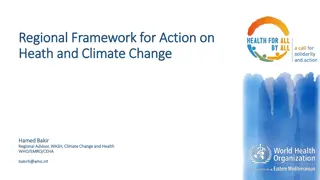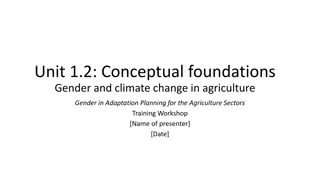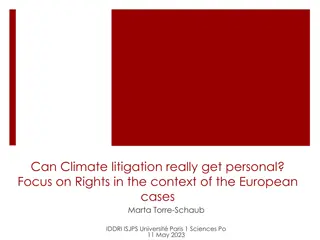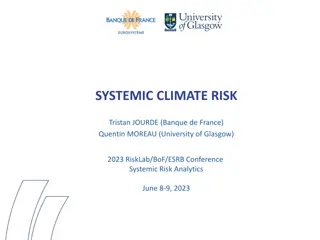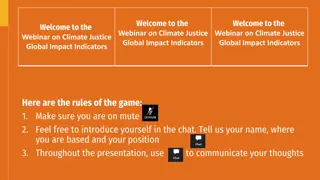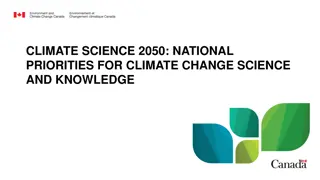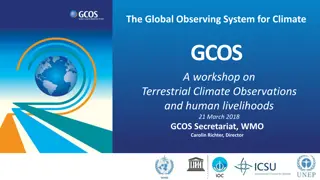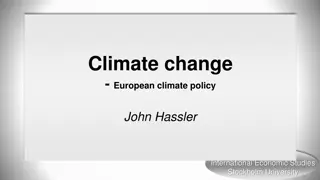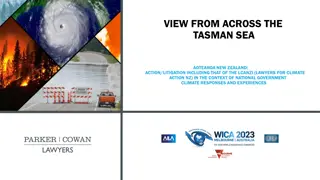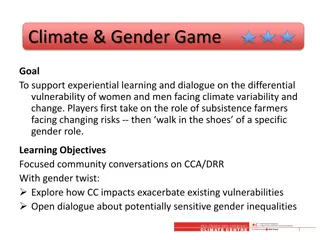Evolution of EU Climate Policy: A Historical Perspective
The history of EU climate policy can be traced back to the 1970s when concerns about global climate change started gaining policy relevance. The 1980s saw increased awareness and the EU's involvement in environmental matters, leading to the adoption of the Single European Act in 1987. In the early 1990s, global impetus and formal climate policy making in the EU began, with the first bid for international leadership in 1988-1992. Key legal principles and emission reduction plans were developed, setting the stage for future climate actions.
Download Presentation

Please find below an Image/Link to download the presentation.
The content on the website is provided AS IS for your information and personal use only. It may not be sold, licensed, or shared on other websites without obtaining consent from the author.If you encounter any issues during the download, it is possible that the publisher has removed the file from their server.
You are allowed to download the files provided on this website for personal or commercial use, subject to the condition that they are used lawfully. All files are the property of their respective owners.
The content on the website is provided AS IS for your information and personal use only. It may not be sold, licensed, or shared on other websites without obtaining consent from the author.
E N D
Presentation Transcript
History of EU climate policy Rahat Sabyrbekov OSCE Academy
1970s - debating 1950s 1970s Concern about global climate change dates back as far as the 1950s, but until the 1970s it was mainly regarded as a scientific issue with little if any policy relevance. Throughout the 1970s, a debate had raged between scientists over whether the climate was warming or even cooling. The 1972 Stockholm Conference agreed to intensify scientific research, a task later taken up by the newly created United Nations Environment Programme (UNEP) 1972
1980s raising awareness These scientific discussions culminated in a major agenda-setting conference held in Villach, Austria, in October 1985. the issue of climate change was therefore beginning to move slowly from the broader systemic agenda to the institutional agenda of issues which directly concern policy makers. Period of heightened environmental awareness internationally and also a point at which the EU s involvement in national environmental matters was beginning to accelerate, Adoption of the Single European Act in 1987.
Energy security and/or Environment Crucially, the EU lacked the legal competence to involve itself in energy matters, and Member States were fiercely opposed to its becoming any more involved in what they perceived to be their own sovereign affairs. Climate change was still being framed mainly as an atmospheric environmental problem, not an energy security one, so the scope for hitching climate change onto the back of energy policy was not great. - SAVE, ALTENER
Early 1990s global impetus In 1987, the US government issued a proposal to create an Intergovernmental Panel on Climate Change (IPCC). In July 1988, the Commission created an interservice group to elaborate preliminary ideas about possible Community action in respect of the Greenhouse Issue It effectively marked the commencement of formal climate policy making in the EU
19881992: the EUs first bid for international leadership November 1989 the first high-level meeting in Nordwijk identified many of the key legal principles such as states having common but differentiated responsibilities to tackle climate change. By 1990, the majority of Member States had established national emission reduction plans and/or targets (Costa 2008: 534). Yet there remained no common EU target.
Not everybody is excited Deep divisions between the greener Member States (e.g. Denmark, Germany and the Netherlands), which had stricter national targets, and the so-called cohesion states (Greece, Spain and Portugal), which either had weaker targets or had none at all Targets and long-term aims, not to the policies and measures 1990s several major failures to develop common actionable policy ( e.g. Carbon tax).
Start of international climate leadership Very quickly environmental policy and with it the fledgling policies on climate change became the lamb which the then Commission President, Jacques Delors, seemed quite prepared to sacrifice to save the wider integration process. Against expectations, hopes began to grow after the UK and Germany announced their readiness to cut their emissions in the period to 2010. The role of USA was important
Introduction to Kyoto Protocol Kyoto Protocol is an international agreement aimed at reducing greenhouse gas emissions It was adopted in 1997 and came into force in 2005 The protocol was developed under the United Nations Framework Convention on Climate Change (UNFCCC)
The primary objective of the Kyoto Protocol is to reduce the emissions of greenhouse gases that contribute to global warming The protocol sets binding targets for developed countries to reduce their greenhouse gas emissions by a certain percentage below 1990 levels The protocol also establishes a framework for emissions trading and the Clean Development Mechanism (CDM), which allows developed countries to offset their emissions by investing in emissions-reducing projects in developing countries
The Kyoto Protocol has been successful in raising awareness about climate change and the need to reduce greenhouse gas emissions The protocol has helped to establish a framework for international cooperation on climate change mitigation However, the overall impact of the protocol on reducing greenhouse gas emissions has been limited, as many countries have not met their emissions reduction targets and some major emitters, such as the United States, did not ratify the protocol.
A brief history of EU environmental policy https://www.youtube.com/watch?v=9y2jcrxnoKM
Thank you! Questions r.Sabyrbekov@osce-academy.net











